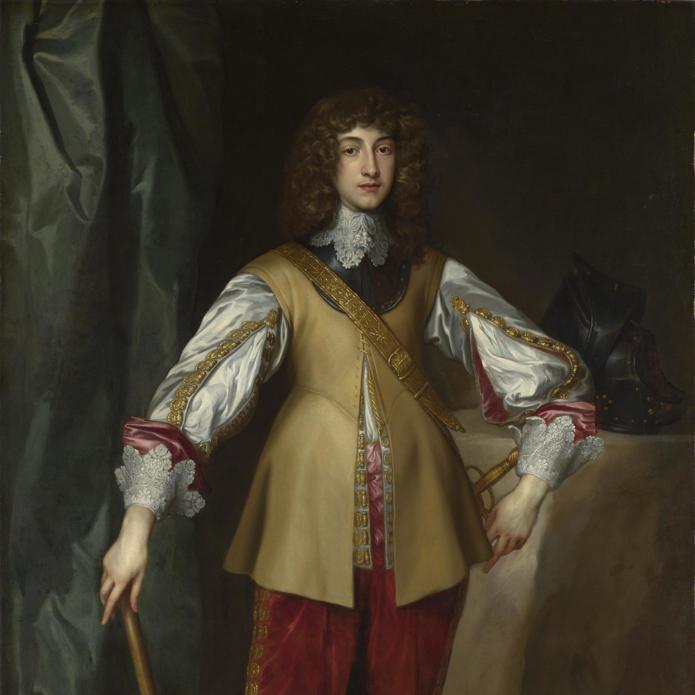Studio of Anthony van Dyck, 'Prince Rupert, Count Palatine', about 1637
About the work
Overview
Elegant and full of self-confidence, the young Prince Rupert stands every inch a member of the royal Stuart dynasty. Known as Rupert of the Rhine, he bears a striking resemblance to his cousin the Prince of Wales, later Charles II. The portrait is designed to place us at his feet, and yet he looks directly at us, a technique common in paintings of royalty. But his gaze doesn't seem to engage us – he is above us, a distant being to be admired and revered.
During the English Civil War, Rupert fought in the Royalist army as a commander of cavalry. At first he met with great success but later, when he failed to hold the city of Bristol for Charles I, he was banished and returned to Europe. When Charles II was restored to the throne in 1660, Rupert became squadron commander in the Royal Navy, active in government and a leading member of the London social scene.
Key facts
Details
- Full title
- Prince Rupert, Count Palatine
- Artist
- Studio of Anthony van Dyck
- Artist dates
- 1599 - 1641
- Part of the series
- The Brothers: Princes Rupert and Charles Louis
- Date made
- About 1637
- Medium and support
- Oil on canvas
- Dimensions
- 216 × 133.3 cm
- Acquisition credit
- Bequeathed by Cornelia, Countess of Craven, 1965
- Inventory number
- NG6363
- Location
- Room 21
- Collection
- Main Collection
- Frame
- 18th-century English Frame
Provenance
Additional information
Text extracted from the catalogue entry in Christopher Baker and Tom Henry, ‘The National Gallery: Complete Illustrated Catalogue’, London 2001; for further information, see the full catalogue entry.
Bibliography
-
1801J. Britton and E.W. Brayley, The Beauties of England and Wales, 19 vols, London 1801
-
1829
J. Smith, A Catalogue Raisonné of the Works of the Most Eminent Dutch, Flemish, and French Painters: In Which is Included a Short Biographical Notice of the Artists, with a Copious Description of Their Principal Pictures […], 9 vols, London 1829-1842
-
1854G.F. Waagen, Treasures of Art in Great Britain: Being and Account of the Chief Collections of Paintings, Drawings, Sculptures, Illuminated Mss. […], vol. 2, trans. E. Eastlake, London 1854
-
1866Catalogue of the Pictures at Combe Abbey, Warwickshire: The Seat of William Earl of Craven, n.p. 1866
-
1882J. Guiffrey, Antoine van Dyck: Sa vie et son oeuvre, Paris 1882
-
1900L.H. Cust, Anthony van Dyck: An Historical Study of his Life and Works, London 1900
-
1967The National Gallery, The National Gallery: January 1965 - December 1966, London 1967
-
1967National Portrait Gallery, National Portrait Gallery. Annual Report to the Trustees 1965-66, London 1967
-
1968E.S. King, 'Whatever He Wills He Wills Vehemently', Bulletin of the Walters Art Gallery, Baltimore, XX/6, 1968
-
1982O. Millar, Van Dyck in England, London 1982-1983
-
1986W.-J. Hoogsteder, De schilderijen van Frederik en Elizabeth, Koning en Koninginn van Bohemen, 's-Gravenhage 1986
-
1992D. Oldfield, Later Flemish Paintings in the National Gallery of Ireland. The Seventeenth to Nineteenth Centuries, Dublin 1992
-
1994O. Millar, 'Philip, Lord Wharton, and His Collection of Portraits', The Burlington Magazine, CXXXVI/1097, 1994, pp. 517-30
-
2001
C. Baker and T. Henry, The National Gallery: Complete Illustrated Catalogue, London 2001
-
2004H. Vey et al., Van Dyck: A Complete Catalogue of the Paintings, New Haven 2004
-
2021J. Peacock, Picturing Courtiers and Nobles from Castiglione to Van Dyck: Self Representation by Early Modern Elites, New York 2021
About this record
If you know more about this work or have spotted an error, please contact us. Please note that exhibition histories are listed from 2009 onwards. Bibliographies may not be complete; more comprehensive information is available in the National Gallery Library.
Images
About the series: The Brothers: Princes Rupert and Charles Louis

Overview
The portraits of these two princes are often displayed in the National Gallery on either side of one of their mother, Elizabeth Stuart, who was the sister of King Charles I of England. The three pictures may well have been shown together in this way since the seventeenth century, and are a testament to the importance of continuity of power to a royal dynasty.
Elizabeth was married to Frederick V, Elector Palatine. After dynastic squabbles involving almost the whole of Europe, they were deposed in 1620 and went into exile. When Frederick died in 1632 Elizabeth sent her three eldest sons to the court of Charles I, to strengthen the family ties and to gain support for their cause. Her eldest surviving son, the heir to the Electoral Palatinate, was Charles Louis; her second son was Rupert, known as Prince Rupert of the Rhine. It was while they were in England that their portraits were painted.


























